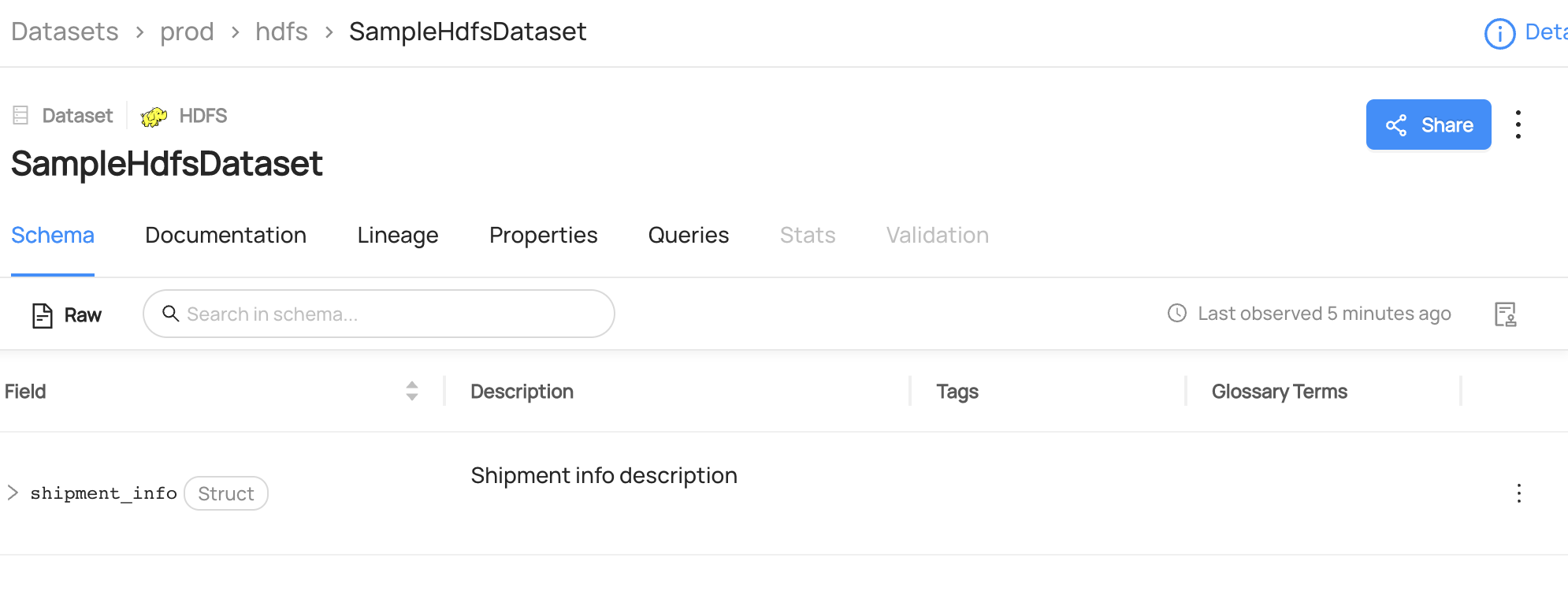Removing Tags From Datasets/Columns
Why Would You Remove Tags?
Tags are informal, loosely controlled labels that help in search & discovery. They can be added to datasets, dataset schemas, or containers, for an easy way to label or categorize entities – without having to associate them to a broader business glossary or vocabulary.
For more information about tags, refer to About DataHub Tags.
Goal Of This Guide
This guide will show you how to remove a Legacy from the shipment_info column of a dataset called SampleHdfsDataset.
Additionally, we will cover how to remove a tag from the dataset or from multiple entities.
Prerequisites
For this tutorial, you need to deploy DataHub Quickstart and ingest sample data. For detailed steps, please refer to Datahub Quickstart Guide.
Before removing tags, you need to ensure the targeted dataset and the tag are already present in your datahub. If you attempt to manipulate entities that do not exist, your operation will fail. In this guide, we will be using data from a sample ingestion. If you want to know how to create tags using APIs & SDKs, please refer to Creating Tags and Creating Datasets.
Remove Tags With GraphQL
Please note that there are two available endpoints (:8000, :9002) to access GraphQL.
For more information about the differences between these endpoints, please refer to DataHub Metadata Service
GraphQL Explorer
GraphQL Explorer is the fastest way to experiment with GraphQL without any dependencies.
Navigate to GraphQL Explorer (http://localhost:9002/api/graphiql) and run the following query.
mutation removeTag {
removeTag(
input: {
tagUrn: "urn:li:tag:Legacy",
resourceUrn: "urn:li:dataset:(urn:li:dataPlatform:hdfs,SampleHdfsDataset,PROD)",
subResourceType:DATASET_FIELD,
subResource:"shipment_info"})
}
Note that you can also remove a tag from a dataset if you don't specify subResourceType and subResource.
mutation removeTag {
removeTag(
input: {
tagUrn: "urn:li:tag:Legacy",
resourceUrn: "urn:li:dataset:(urn:li:dataPlatform:hdfs,SampleHdfsDataset,PROD)",
}
)
}
Note that you can also remove tags from multiple entities or subresource using batchRemoveTags.
mutation batchRemoveTags {
batchRemoveTags(
input: {
tagUrns: ["urn:li:tag:Legacy"],
resources: [
{ resourceUrn:"urn:li:dataset:(urn:li:dataPlatform:hdfs,SampleHdfsDataset,PROD)"} ,
{ resourceUrn:"urn:li:dataset:(urn:li:dataPlatform:hive,fct_users_created,PROD)"} ,]
}
)
}
If you see the following response, the operation was successful:
{
"data": {
"removeTag": true
},
"extensions": {}
}
CURL
With CURL, you need to provide tokens. To generate a token, please refer to Access Token Management.
With accessToken, you can run the following command.
curl --location --request POST 'http://localhost:8080/api/graphql' \
--header 'Authorization: Bearer <my-access-token>' \
--header 'Content-Type: application/json' \
--data-raw '{ "query": "mutation removeTag { removeTag(input: { tagUrn: \"urn:li:tag:Legacy\", resourceUrn: \"urn:li:dataset:(urn:li:dataPlatform:hdfs,SampleHdfsDataset,PROD)\" }) }", "variables":{}}'
Expected Response:
{ "data": { "removeTag": true }, "extensions": {} }
Remove Tags With Python SDK
The following code removes a tag named Legacy from shipment_info column of a dataset called SampleHdfsDataset.
Coming Soon!
We're using the MetdataChangeProposalWrapper to change entities in this example.
For more information about the MetadataChangeProposal, please refer to MetadataChangeProposal & MetadataChangeLog Events
Expected Outcomes
You can now see Legacy tag has been removed to shipment_info column.

